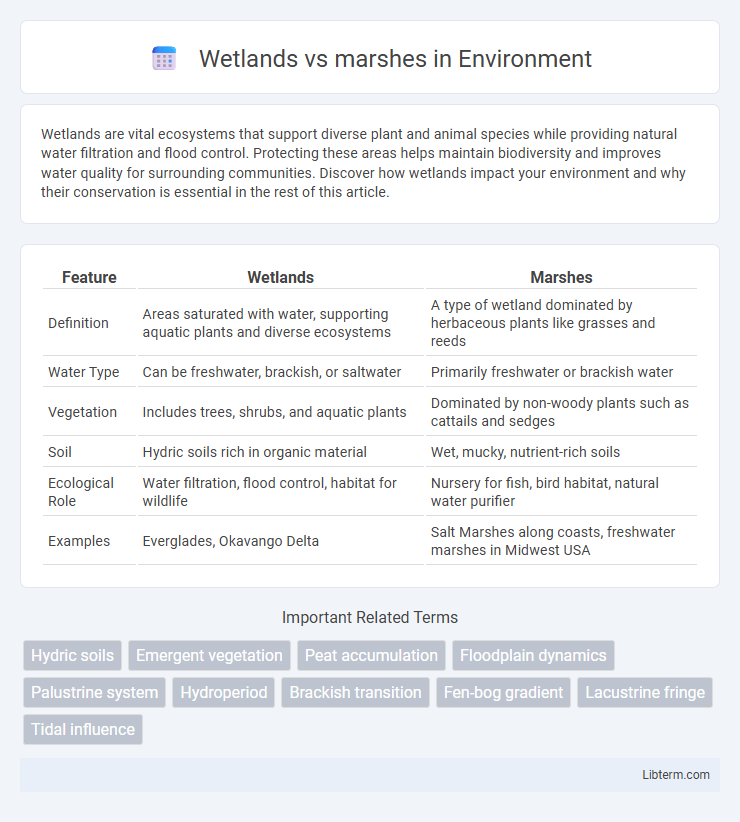Wetlands are vital ecosystems that support diverse plant and animal species while providing natural water filtration and flood control. Protecting these areas helps maintain biodiversity and improves water quality for surrounding communities. Discover how wetlands impact your environment and why their conservation is essential in the rest of this article.
Table of Comparison
| Feature | Wetlands | Marshes |
|---|---|---|
| Definition | Areas saturated with water, supporting aquatic plants and diverse ecosystems | A type of wetland dominated by herbaceous plants like grasses and reeds |
| Water Type | Can be freshwater, brackish, or saltwater | Primarily freshwater or brackish water |
| Vegetation | Includes trees, shrubs, and aquatic plants | Dominated by non-woody plants such as cattails and sedges |
| Soil | Hydric soils rich in organic material | Wet, mucky, nutrient-rich soils |
| Ecological Role | Water filtration, flood control, habitat for wildlife | Nursery for fish, bird habitat, natural water purifier |
| Examples | Everglades, Okavango Delta | Salt Marshes along coasts, freshwater marshes in Midwest USA |
Wetlands vs Marshes: Key Differences
Wetlands encompass a broad category of saturated land areas including marshes, swamps, and bogs, characterized by waterlogged soils and distinct ecosystems supporting diverse plant and animal species. Marshes specifically refer to wetlands dominated by herbaceous plants such as grasses, reeds, and sedges, and are frequently found along rivers, lakes, and coastal regions with shallow water. The primary differences lie in vegetation type and hydrology, with marshes having more open water and emergent plants, while other wetlands may contain woody plants or peat accumulation.
Defining Wetlands: Types and Features
Wetlands encompass diverse ecosystems characterized by saturated soils and distinct hydrophytic vegetation, including marshes, swamps, bogs, and fens. Marshes are a specific type of wetland dominated by herbaceous plants such as cattails and reeds, typically found in freshwater or brackish water environments. These wetlands play crucial roles in water filtration, flood control, and providing habitats for a wide variety of wildlife species.
What Makes a Marsh? Core Characteristics
A marsh is a type of wetland characterized by herbaceous rather than woody plant species, typically dominated by grasses, reeds, and sedges. It features saturated soils and standing or slow-moving water that promotes high biodiversity and productivity. Marshes serve critical ecological functions such as water filtration, flood control, and habitat provision for diverse wildlife, including amphibians, birds, and aquatic invertebrates.
Ecosystem Services: Wetlands and Marshes
Wetlands provide critical ecosystem services such as water filtration, flood control, carbon sequestration, and habitat provisioning for diverse species. Marshes, a type of wetland dominated by herbaceous plants, excel in nutrient cycling and serve as breeding grounds for fish and migratory birds. Both ecosystems contribute significantly to groundwater recharge and climate regulation through their unique hydrological functions.
Biodiversity in Wetlands and Marshes
Wetlands encompass a variety of ecosystems, including marshes, swamps, and bogs, each supporting diverse plant and animal species adapted to water-saturated soils. Marshes, a type of wetland dominated by herbaceous plants such as cattails and reeds, provide critical breeding habitats for amphibians, waterfowl, and numerous invertebrates. The high nutrient availability and hydrological conditions in both wetlands and marshes foster rich biodiversity, making them essential for maintaining ecological balance and supporting endangered species.
Hydrology: Water Sources and Cycles
Wetlands encompass diverse ecosystems characterized by water saturation, including marshes which specifically feature shallow, standing water from surface or groundwater sources. Hydrologically, wetlands rely on periodic flooding, precipitation, and groundwater inflow, maintaining saturated soil conditions essential for nutrient cycling and habitat stability. Marshes typically exhibit dynamic water levels influenced by seasonal rainfall, river overflow, or tidal action, supporting unique aquatic vegetation adapted to fluctuating hydrology.
Vegetation: Plant Life in Wetlands vs Marshes
Wetlands feature diverse vegetation including trees, shrubs, and herbaceous plants adapted to water-saturated soils, while marshes predominantly host herbaceous plants such as cattails, sedges, and grasses. Marsh vegetation thrives in standing or slow-moving freshwater or saltwater, forming dense, tall grasses and reeds that provide critical habitat for wildlife. The distinct plant life in marshes plays a key role in nutrient cycling and water filtration, differentiating them from broader wetland ecosystems with more varied plant structures.
Geographic Distribution and Examples
Wetlands encompass diverse ecosystems found globally, including swamps, bogs, and marshes, which are predominantly located in coastal regions, river basins, and floodplains. Marshes, a specific type of wetland, frequently occur in temperate and tropical zones such as the Florida Everglades in the USA and the Camargue in France, characterized by herbaceous plants rather than woody vegetation. The distribution of marshes is often linked to shallow water conditions and nutrient-rich soils, distinguishing them from other wetlands like peat bogs or wooded swamps.
Human Impact: Threats and Conservation
Wetlands face significant threats from human activities such as urban development, agriculture, and pollution, leading to habitat loss, altered hydrology, and decreased biodiversity. Marshes, a specific type of wetland characterized by herbaceous plants and periodic flooding, are especially vulnerable to drainage and land reclamation efforts that disrupt natural water flow and ecosystem functions. Conservation strategies prioritize wetland restoration, protection of water quality, and sustainable land-use practices to safeguard marsh habitats and maintain their critical ecological services.
Choosing the Right Term: Wetland or Marsh?
Choosing the right term between wetland and marsh depends on the specific ecological characteristics and hydrology of the area. Wetlands encompass various ecosystems including marshes, swamps, and bogs, characterized by saturated soils and water-tolerant vegetation, while marshes specifically refer to wetlands dominated by herbaceous plants like grasses and reeds. Accurate terminology is essential for environmental management, conservation policies, and scientific research to ensure clear communication and appropriate resource allocation.
Wetlands Infographic

 libterm.com
libterm.com